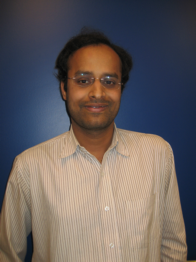Lab-on-a-chip surface plasmon resonance biosensor for multiplex bioassays
Promotion date: 12. March 2010
Promotor: Prof. Dr. Ir. Albert van den Berg
Assistant Promotors: Dr. Ir. Edwin Carlen and Dr. Ir. Richard Schasfoort
| The main goal of the project is to integrate surface plasmon resonance (SPR-)based biosensors with an electro-kinetic lab-on-a-chip, for multiple biomolecular interaction measurements with high-throughput. The thesis describes a successful operation of a newly developed integrated biosensor system, which needs a single voltage supply only. Initially, the chip consisted of a large interaction chamber with multiple measurement sites, and the sample was focussed electro-kinetically from one location of the chip to the other. The chip design was modified later, by replacing the large interaction chamber with individual microchannels, for different and multiple biomolecular interaction measurements in parallel. The electro-kinetic lab-on-a-biochip was demonstrated with various biomolecular interaction experiments, including multi-ligand/multi-analyte detection. Finally, the device was scaled up to twelve channels. Also, ways to improve such a device for real-time bio-applications were discussed. |
How can your thesis project best be classified: application oriented or fundamental?
The initial goal was to construct a multiplex chip, to perform several parallel measurements, delivering high-throughput. Even though I had a clear application device in mind from the beginning, I experienced fundamental difficulties integrating electro-kinetics into the SPR biosensors. During the process electro-kinetics proved to be the most critical part in this new biosensor and micro-array concept.
The advantages however were obvious from the start. No complex plumbing devices, like valves and pumps, were needed anymore. After two years of work, I had some very positive results on these integrated biosensors. The following process, the scaling up of the concept, to twelve channels, was relatively easy.
Did Mesa+ colleagues support your work a great deal?
All kind of coaching was available, literally at any time. With Edwin Carlen, for example, we had discussions going on per email, even in the middle of the night.
The BIOS-group contains a tremendous knowledge on bio-chips, and the staff has a mature scientific vision on research. Furthermore, the cleanroom facilities are one of the best in the world, I believe, getting great support by the experienced technicians working there. Financially, a lot of possibilities were available to perform some special techniques.
How did you come into contact with Mesa+?
I met some MESA+ people at a conference, while performing my master studies in Germany. Later on, I found an interested project in the former Biochip group.
After I contacted, they called me back quickly, and responded very kindly to my questions, which I find extremely important. Also, when I browsed the internet to learn more about MESA+, I could only find good and interesting stories. So, I opted to choose the project that was offered to me.
Did your work lead to some nice publications?
After two and half years, I had an article published in Analytical Chemistry, followed by another one in Analytical Methods, including the cover page design of that issue. Quite recently, a story appeared in the Lab-on-a-Chip Journal.
We also submitted three more articles in high-impact and well-reputed journals. Two times I had an article published in the proceedings of Micro-Tas as well.
Further, the Gordon Research Conferences in the USA and Italy, were top-rated events for me. I had some poster presentations, leading to great discussions with people from around the world, all involved in micro-fluidics.
What are your future plans?
I will start working as a post-doctoral researcher in the Transducers Science & Technology group of professor Miko Elwenspoek under the guidance of dr. ir. Niels Tas. This project is more technology-oriented. The research is aimed towards real applications. It is stimulating for me, to know that my work goes out into the real world, at some stage of its development.
The main task here, lies in the efficient delivery of Hepatitis-B vaccination, using a micro-needle, in which microfluidics will also play an important role. I hope to learn more on how to handle these kind of projects, to set my own goals, and work within well-defined time limits.

